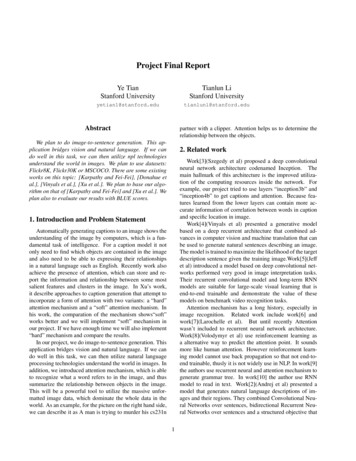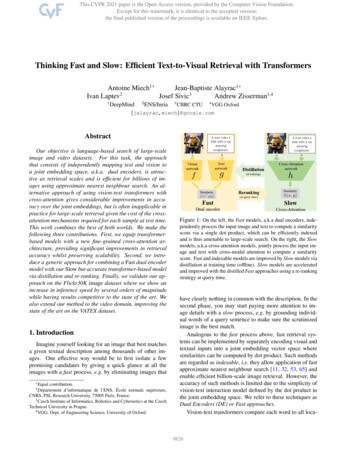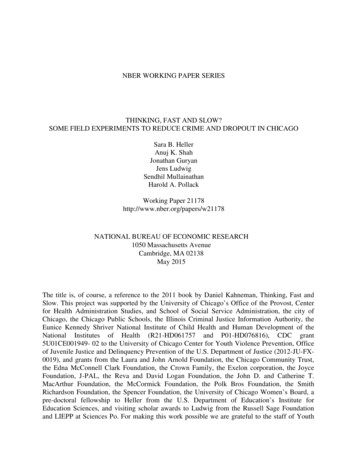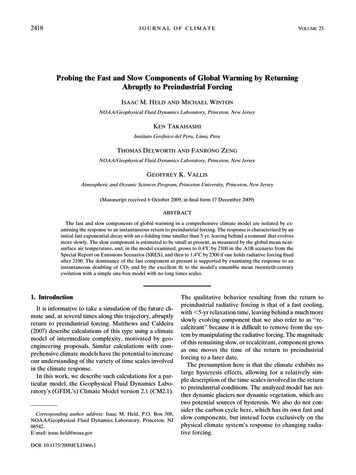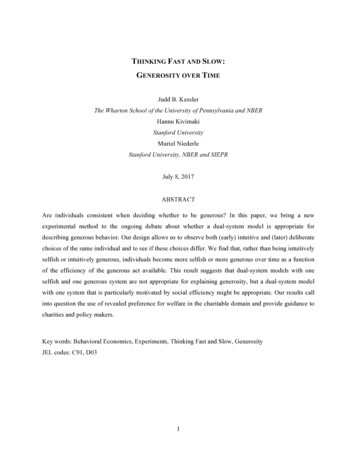
Transcription
THINKING FAST AND SLOW:GENEROSITY OVER TIMEJudd B. KesslerThe Wharton School of the University of Pennsylvania and NBERHannu KivimakiStanford UniversityMuriel NiederleStanford University, NBER and SIEPRJuly 8, 2017ABSTRACTAre individuals consistent when deciding whether to be generous? In this paper, we bring a newexperimental method to the ongoing debate about whether a dual-system model is appropriate fordescribing generous behavior. Our design allows us to observe both (early) intuitive and (later) deliberatechoices of the same individual and to see if these choices differ. We find that, rather than being intuitivelyselfish or intuitively generous, individuals become more selfish or more generous over time as a functionof the efficiency of the generous act available. This result suggests that dual-system models with oneselfish and one generous system are not appropriate for explaining generosity, but a dual-system modelwith one system that is particularly motivated by social efficiency might be appropriate. Our results callinto question the use of revealed preference for welfare in the charitable domain and provide guidance tocharities and policy makers.Key words: Behavioral Economics, Experiments, Thinking Fast and Slow, GenerosityJEL codes: C91, D031
I. INTRODUCTIONSignificant attention in behavioral economics has been devoted to explaining why the same individual,faced with the same set of options, might make different choices at different times. Such models includeprojection bias (Loewenstein, O'Donoghue and Rabin, 2003), theories of consumption that depend oncues or emotions (Laibson, 2001), and hyperbolic discounting (Strotz, 1956; Laibson, 1997; O’Donoghueand Rabin, 1999, 2001).1 Many of these models rely on differences in the environment or mental state(e.g., making choices about bundles today compared to tomorrow; making choices while happy or angry),even as the set of choices remain the same.2 A more recent literature in psychology and behavioraleconomics has posited that even if there are no extraneous changes in environments or mental states,individuals may make predictably different choices when they take more time to make a decision. Thesedual-system or dual-process models suggest that a fast and intuitive system (or hot, instinctive, orautomatic system) may make systematically different choices than a slower and more calculating system(or a cold, reflective, or controlled system), see Kahneman (2003, 2011, 2013).3 In economics, dual-selfmodels operate under a similar premise, although they often incorporate a strategic interaction betweenthe two selves, as in Bernheim and Rangel (2004), Benhabib and Bisin (2005), and Fudenberg and Levine(2006).Specific attention has been paid to whether the intuitive and fast system is more altruistic — that is,whether individuals show more generosity when choices are made quickly.4 The recent Social HeuristicsHypothesis (see Rand et al., 2014 and Bears and Rand, 2016) argues that fast, intuitive responses areshaped by past experience and prescribe behavior that is typically advantageous in daily life socialinteractions. In these interactions, which are often repeated, cooperative behavior may be optimal and sothe intuitive system adopts cooperative or altruistic tendencies. In contrast, deliberation allows a decisionto adjust to the specific social situation, such as being selfish in response to an anonymous, one-shot1For empirical validation of these models, see e.g. Conlin et al. (2007); Simonsohn (2010); Schwarz and Clore(1983); Lerner, Small and Loewenstein (2004); Kirchsteiger, Rigotti and Rustichini (2006); Frederick, Loewenstein,and O’Donoghue (2002); Augenblick, Niederle and Sprenger (2015); Kessler, McClellan and Schotter (2016).Additional very recent models and evidence include work on attribution bias (Haggag and Pope, 2016) and learningwith misattribution of preferences (Bushong and Gagnon-Bartsch, 2016a, 2016b).2For example, Grimm and Mengel (2011) show that rejections in the ultimatum game are reduced if the responderhas a few minutes to “cool down” before deciding whether to accept or reject an offer.3In psychology, dual process theories have their origins in the 1970’s (Wason and Evans, 1975; Posner and Snyder,1975; and Schneider and Shiffrin, 1977). For more recent work see Sloman (1996); Gilovich, Griffin and Kahneman(2002); and Sanfey, Loewenstein, McClure and Cohen (2006) as well as overviews by Evans (2008), Weber andJohnson (2009), and Evans and Stanovich (2013).4Interestingly, the fast and intuitive system was initially thought to be more selfish (see, e.g., DeWall et al., 2008),as a common view was that the fast and intuitive system is shared with animals that are generally considered to beselfish and aggressive (Dawkins, 1976). More recently, the view that the intuitive system is more generous hasbecome more popular. For a discussion on this change, see Zaki and Mitchell (2013).2
giving opportunity. The evidence for showing that earlier, faster choices are more generous consists ofresults in two paradigms. In the first paradigm, researchers correlate response times with choices (Rand,Greene and Nowak, 2012). In the second paradigm, researchers aim to experimentally manipulate thesystem or process that makes a decision, for instance by requiring subjects to either answer quickly orslowly (Rand, Greene and Nowak, 2012). Both these paradigms have come under considerable attack,casting doubt on whether — within an individual — an early, fast, intuitive choice is predictably moregenerous than a later more deliberate choice.5 Indeed, there is no satisfactory evidence ruling out thestandard story that individuals exhibit stable choices in situations where they decide between a selfish orgenerous act; and, hence, there is no satisfactory evidence on whether dual-system models have empiricalvalue for generous behavior.In this paper, we directly test whether an individual’s generosity reliably changes the longer the individualdeliberates on a decision. We use an experimental technique introduced by Caplin, Dean and Martin(2011), which incentivizes choices of agents over time. Subjects face 10 prisoner’s dilemmas and 10dictator games. In each question, subjects decide whether or not to transfer 1 to give X to anothersubject, where X ranges from 0 to 10 across questions. For each question, subjects have 60 secondsduring which they can record an initial answer and then subsequently change their answer if they wouldlike to do so. For the specific question that is chosen for payment, one of the 60 seconds is randomlyselected, and the choice recorded by the subject at that second is the choice implemented for payment. Ifno choice is made at the randomly chosen second, both the decision maker and the other subject earnnothing. The subject is therefore incentivized to make a fast initial choice and also to change the choice assoon as possible whenever the subject considers a different choice to be optimal.We find that most subjects change their choices in at least some questions. Our main result is that at lowexchange rates, subjects become less generous over time, consistent with the previous literature. Incontrast, however, at high exchange rates — when being generous is more efficient — subjects becomemore generous over time. We have several robustness tests and control treatments to confirm that thesechanges are not due to subjects providing first choices that are random or reasonless and later correctingthose choices. Another alternative explanation for our results is that first choices, while not completelyrandom, are still only imperfect implementations of fixed underlying preferences because subjects needtime to process exchange rate information. We explicitly test this alternative hypothesis and can rule it5We discuss in Section III how the work of Rubinstein (2016), Recalde, Riedl and Vesterlund (2014), Krajbich et al.(2015), Tinghög et al. (2013), and Bouwmeester et al. (2017), among others, cast doubt on the conclusions based onthe existing evidence from these paradigms.3
out. We conclude that subjects reliably change their preferences, responding more to exchange rates overtime when deciding whether to be generous and becoming systematically less generous at low exchangerates and more generous at high exchange rates.We therefore provide direct evidence that choices in decisions involving generosity predictably changewhen comparing early choices to later choices made after deliberation. Our findings support modelinggenerous behavior with a dual-system or dual-process model. However, we should not consider one of thesystems to be generous and the other to be selfish. Instead, we may want to model the slow and deliberatesystem as caring more about social efficiency than the intuitive system. As such, our results lend supportfor the dual-process model of Loewenstein and Small (2007), which posits one immature and irrationalprocess, called “sympathy,” and another rational but more uncaring process, called “deliberate.”6 Notethat our experiment is not designed to address whether there is an inherent strategic conflict between thetwo systems (as in most dual-self models) or whether different systems simply differ in their preferredchoices.Our results imply that welfare considerations based on revealed preference may be complicated whenanalyzing decisions involving generosity. With conflicting preferences between systems, it may not beobvious which system prefers the selected choice, and it may also not be clear which preferences weshould honor for welfare analysis. Our results also speak to how individuals can be encouraged to donateto charity or to provide other public goods. The findings of our experiments suggest that less-efficientcharities should encourage fast donation decisions (for example, by asking for donations in time-sensitivesituations) while efficient charities should encourage potential donors to deliberate about giving. Wediscuss these implications in the conclusion.The rest of the paper proceeds as follows. Section II describes the experimental design. Section IIIoutlines hypotheses for behavior that motivated our design. Section IV presents our main results. SectionV presents robustness tests. Section VI introduces an additional control treatment showing that our resultsare due to changing preferences rather than computational difficulties. Section VII discusses how ourresults speak to the literature on fast and slow choices and the drift diffusion model. Section VIIIconcludes.6Our results are aligned with a recent investigation that uses a technique similar to the one employed in this paper.Dyrkacz and Krawczyk (2015) ask subjects to answer the questions from Charness and Rabin (2002) and allow themto change their choice at most once within 60 seconds. They find evidence that more deliberation leads to lesspronounced disadvantageous inequality aversion, but their results include data consistent with more deliberationleading to more efficient outcomes.4
II. EXPERIMENTAL DESIGNII.1. GamesOur main set of experimental subjects play 10 dictator games and 10 prisoner’s dilemmas. In each ofthese 20 questions, subjects face a binary decision: either give-up 1 to transfer X to another subject, orkeep the 1 and transfer 0. For each game type (dictator game and prisoner’s dilemma) each subject saw10 different X values: 0, ½, 1, 2, 3, 4, 5, 6, 8, and 10, in random order.In each prisoner’s dilemma (denoted “PD X” where X is the exchange rate), the subject is endowed with 1. Her payoff depends on her decision as well as the decision of another subject who has the sameopportunity to give up 1 in order to transfer X. Each prisoner’s dilemma has a corresponding dictatorgame (denoted “DG X” where X is the exchange rate) in which the dictator is endowed with X 1, whichis the amount of money the subject would have if she were playing in the corresponding PD X and theother player decided to transfer the 1. For a given exchange rate X, the payoffs PD X and DG X aregiven by Table 1.Table 1: Payoffs in the games for a given exchange rate XDG XPDXOther subject’s decisionTransferDo not TransferX, X0, X 1X 1, 01, 1Subject’s DecisionTransferDo not TransferX, XX 1, 0II.2. Choices over TimeWe employ an experimental technique introduced by Caplin, Dean and Martin (2011) that incentivizeschoices of agents over time.7 Before each question, subjects are shown a screen for 10 seconds thatdescribes the question they are about to answer but withholds information about the exchange rate X.Subjects are then shown the relevant parameter (i.e., the exchange rate X) and have 60 seconds on thedecision screen.8 At each point during those 60 seconds, subjects can record an initial answer or changetheir answer. As shown in Figure 1, the decision screen reminds subjects of their current choice, lists theirprevious choices, and has a timer indicating how many of the 60 seconds remain. For the question that ischosen for payment, one of the 60 seconds is randomly selected and the choice recorded by the subject at7Agranov, Caplin and Tergiman (2015) uses the same technique to study behavior in guessing games.To ensure subjects are ready for a question to begin, subjects see a waiting screen that required them to press abutton to advance to the next question. Only after they press this button do they see the instructions for 10 seconds,followed by the decision screen for 60 seconds.85
that second is implemented for payment. If subjects have not yet made an initial decision at the randomlychosen second, they receive no payment for that question (and neither does the other subject). We callthese “timed” questions to distinguish them from questions answered in the standard way (i.e., in which asubject takes as much time as she wants to record one answer), which we call “untimed” questions.Figure 1: The decision screen for timed questions.Notes: Figure 1 shows how the decision screen would look in the DG 5 question if a subject first made achoice of “Do not transfer 1” and then switched to “Transfer 1” at some point in the first 7 seconds ofthe minute. A subject who has not yet made a choice would see both buttons in light gray, just like the“Do not transfer 1” button appears here.While the payments in the dictator game are straightforward, the payment of a subject in the prisoner’sdilemma also depends on the choice of the other subject. Specifically, we tell subjects that their earningswill depend on what the other subject choses at second 15 (or 45).9 The number 15 or 45 was randomlyselected at the subject level, and the same number was used for all the prisoner’s dilemma questions thatsubject answered. Even though our decision maker of interest is being given the opportunity to potentiallychange her choice over time, we fix the second for the other subject’s choice to rule out changes inbehavior arising from decision makers who want to match the choice of the other subject and believe that9Specifically, before each of the 10 dictator games, the instructions read: “In this question you are paired withsomeone else in the study. Your choice alone affects how much money you and that other person will receive in thestudy.” Before each of the 10 prisoner’s dilemmas the instructions read: “In this question you are paired withsomeone else in the study. Your choice and their choice both affect how much money you and that other person willreceive in the study. You have the opportunity to transfer money to them and they have the exact same opportunityto transfer to you. Your earnings will depend on what they choose at second [15/45].”6
the other subject is getting more selfish or more generous over time. Our design guarantees that eachdecision maker is facing a static choice from the other subject over the course of the 60 seconds.This experimental paradigm allows us to observe choices of subjects over time. That is we have thepotential to observe an early “intuitive” choice and a different, later “deliberate” choice. Because subjectsreceive no payment if there is no answer recorded at the randomly chosen second, subjects have anincentive to answer quickly. This feature makes us optimistic that initial answers recorded by subjectswill be intuitive rather than deliberate choices. One concern, however, is that the experimental paradigmmight also lead subjects to initially record a random or immediate choice (i.e., a choice made before thesubject has even read the question or had time to generate an intuitive answer), which we call a“reasonless” choice. Recording a random answer may in fact be rational depending on a subject’s beliefsabout the likelihood that some answers are associated with negative payoffs and/or the extent to whichrecording a random choice slows down a subsequent choice that is a function of the parameter. In SectionII.3, we describe the control treatments we use to determine to what extent initial choices are reasonless.In addition, in Section V, we use data from the main experiment to once more evaluate the extentof reasonless choices. The structure of the incentives in timed questions also guarantees that as soon as asubject would like to make a different choice, she should implement the new choice as quickly aspossible, thereby increasing the probability it will be recorded at the second randomly selected forpayment. Specifically, at each moment, a subject should have recorded the choice that she considersoptimal. Consequently, later answers should reflect deliberate choices.II.3. Control TreatmentsTo measure how long subjects take to make a choice in dictator games and prisoner’s dilemmas whenthey are not under time pressure to record a first choice, we ran two control treatments in which subjectsanswered questions in the standard “untimed” way. In those, subjects answered 10 timed questions of onegame type and then answered 10 untimed questions of the other game type.10 Subjects answering untimedquestions saw the same decisions screen as in Figure 1 but without the timer or table of choices (seeFigure A1 in the Appendix). Subjects had as many seconds as they wanted before they made a singledecision.We ran two versions of the untimed control treatments. In the “last choice” treatment, after subjects madea choice they had to click a decision button to advance to the next screen for the choice to be implemented10For example, if subjects’ timed questions were dictator games, then their untimed questions were prisoner’sdilemmas.7
(the decision button is labeled “ ” in Figure A1). In particular, they could click either of the two choicebuttons (i.e., “Transfer 1” and “Do not transfer 1”) as often as they wished, but only their last choicewas implemented as their answer to the question. In this “last choice” control treatment, the time ofchoice is recorded as the last time at which the subject clicked one of the two choice buttons — “Transfer 1” or “Do not transfer 1” — before clicking the decision button to implement their choice.While having the option to click multiple choice buttons resembles the timed treatment, it could be thatsubjects still thought about their answer between the time they last clicked one of the two choice buttonsand the time at which they clicked the decision button to implement their choice. We therefore ran asecond version of the untimed control treatment that, while depriving subjects of the ability to clickmultiple buttons, measures precisely how long a subject takes to submit a final answer. In the “singlechoice” control treatment, subjects faced the same screen as in Figure A1 but without the decision button.Subjects could take as much time as they wanted to make a choice, but as soon as a subject clicked oneither the “Transfer 1” or “Do not transfer 1” button, that choice was implemented as their answer tothe question. The time of the choice for the “single choice” control treatment was simply the time atwhich the subject clicked one of the two choice buttons.We ran a final control treatment to investigate the extent to which subjects have difficulty in processinginformation about the exchange rate X, which we introduce here and discuss in detail in Section VI. In the“accounts” treatment, subjects make the same choices about whether to transfer 1 for X as in dictatorgames, but they also receive the X generated as a result of the transfer. That is, we eliminate the othersubject and thus eliminate generosity as a motive for making the transfer. In particular, subjects are toldthat: they have two accounts, they receive the money in both accounts, and transferring 1 from oneaccount gives X to the other account. A subject who wants to maximize their payoffs, just like a subjectwho wants to maximize the sum of payoffs in the dictator game, should transfer 1 whenever theexchange rate X is 2 or higher and should not transfer 1 when the exchange rate X is 0.5 or 0. To ensurethat we can compare choices and how long subjects took to make them, the interface of the accountstreatment mirrors that of the dictator game as much as possible (see Figure A2 in the Appendix).11In all treatments, subjects were paid based on their choices for one randomly selected question.12 Wedescribe the subject pool in Section IV.11Subjects who answered the 10 “account” questions then answered 10 dictator games or the prisoner’s dilemmas inthe “single choice” control treatment.12The instructions for all treatments are available in Appendix B. After being asked the dictator game and prisoner’sdilemma questions for this study, most subjects also answered a timed “sanity check” question that asked them8
III. THEORYIn this section, we discuss the hypotheses for behavior that motivate our experimental design. We indicatehow we test between competing hypotheses and discuss the related literature by highlighting howprevious results speak to these hypotheses.Hypothesis I: Stable preferences and choices. This hypothesis posits that optimal choices of subjects donot change over time. Much of the previous work that claims to support dual-system models uses eithercorrelational evidence (e.g. comparing fast to slow choices) — so cannot directly rule out hypothesis I —or attempts to experimentally manipulate the cognitive process making a decision (e.g., by varying time toa decision) — leading to selection problems that have met with harsh criticism.The literature that compares choices of fast and slow subjects typically finds that selfish individuals areslower in making choices.13 However, for such findings to be evidence of a dual-system model, or to ruleout hypothesis I, one must assume that subjects are similar in their thought processes, but some happen toanswer questions fast (and hence make intuitive choices) while others answer slowly (and hence makedeliberate choices). Three criticisms challenge this central assumption and suggest other reasons whyresponse time might correlate with choices, even among individuals with stable preferences. The firstcriticism is the most direct, namely that differences in reaction time may be due to selection rather thantreatment. For example, Rubinstein (2016) argues that people who make fast choices are different fromthose who make slow choices. The second criticism posits that, rather than being intuitive, choices thatare fast are less responsive to parameters and more “reasonless”.14 Recalde, Riedl and Vesterlund (2014)show that by changing the parameters of the game to make reasonless choices more or less generous, fastchoices by subjects can be made to be either more or less generous (see also Rubinstein 2007, 2013). Thethird criticism is that single-system choice models that argue that reaction time is a function of the“difficulty” of a decision (such as evidence accumulation or drift diffusion models) also lead to aggregatewhether they wanted to earn - 1, 0, or 1 for the question. Of the 466 subjects asked this question, 464 (99.6%)answered 1 as their last recorded choice (the other 2 selected 0 as their last recorded choice), suggesting thatsubjects understood how the timed questions worked. In addition, after making all choices for this study, somesubjects were asked additional, unrelated timed and untimed questions to pilot questions for other studies.13See Rubinstein (2007) on the ultimatum game; Rand, Greene and Nowak (2012), Lotito, Migheli and Ortona(2013), and Nielsen, Tyran and Wengström (2014) on public good games; and Cappelen et al. (2016) on dictatorgames. However, not all findings follow this pattern. Piovesan and Wengström (2009) find that selfish choices indictator games are faster and Lohse, Goeschl and Diederich (2016) find that those who decide to keep money ratherthan contribute to climate change mitigation efforts decide faster.14Rubinstein (2007) classifies an action as “reasonless” if it is likely to be the outcome of a random process withlittle or no reasoning about the decision problem.9
correlations between decision speeds and choices (for more detail see Section VII).15 All three criticismsdirectly attack the presumption that choices of fast subjects differing from choices of slow subjects isevidence that individuals have two systems that make predictably different choices. To summarize,correlational evidence cannot rule out hypothesis I.16The second leading method to investigate dual-system models is to experimentally manipulate thecognitive process and assess the impact on choices. The most common manipulation is time pressure, inwhich subjects are asked to make choices either very quickly or to not make a choice before a specifiedamount of time has elapsed. For example, in Rand, Greene and Nowak (2012) subjects in a four-playerpublic good game were randomly asked to record a choice in the first 10 seconds, or after 10 seconds hadpassed. While subjects under time pressure contribute more to the public good than those under timedelay, only half of the subjects in the time pressure condition comply (compared to about 80% in the timedelay condition). This failure to comply has sparked a controversy (see Tinghög et al., 2013). ARegistered Replication Report (Bouwmeester et al., 2017) of Rand, Greene and Nowak (2012) confirmsthat selection is an important driver for the result that choices under time pressure differ from choicesunder time delay.17 Other manipulations of the cognitive process include cognitive load, ego-depletion,and asking subjects to use an intuitive or deliberate decision process. Each of these approaches has metwith their own criticisms.1815These models predict that less conflicted individuals, that is, individuals who have a larger difference in utilitybetween the two available options, make faster choices. Hence, when giving is very efficient, generous subjects willbe less conflicted than selfish subjects, and hence a heterogeneous pool of subjects with stable preferences will leadto fast choices being more generous than slow choices. The opposite will be the case when giving is less efficientand hence generous subjects are more conflicted than selfish ones. Krajbich et al. (2015) provide evidence thatdependent on the efficiency of giving in public good games, fast choices are sometimes more generous than slowchoices (efficient giving) and sometimes less generous (inefficient giving). For a theoretical model of such anoptimal sequential sampling problem, see Fudenberg, Strack and Strzalecki (2015). Evans, Dillon and Rand (2015)also argue that decision conflict drives reaction times. See also Hutcherson et al. (2015).16While the criticisms argue that the evidence comparing fast to slow subjects is consistent with hypothesis I, it ofcourse does not prove it. For example, while there may be heterogeneity across subjects, or while drift diffusionmodels may guide the speed of decisions, it could still be that when a specific person keeps deliberating about adecision problem, his later choices predictably differ from his early ones. Indeed, we will show evidence thatdecisions change over time within an individual.17Specifically, the replication report involved 3596 participants from 21 laboratories. Across this data, 92.5% ofsubjects complied in the time delay treatment but only 34.1% complied in the time pressure treatment. When noncompliant subjects are included in the data, there is no effect of time pressure on contribution — if anything, thoseunder time pressure were 0.37 percentage points less generous. See also Rand’s comment on the RegisteredReplication Report, Rand et al. (2014), and Rand (2016) on meta-analyses on experimentally promoting intuitivechoices or deliberate choices.18In cognitive load studies, subjects engage in an easy or difficult cognitive task while participating in a game. Inego-depletion studies the idea is the same, only that instead of performing the cognitive task while making choices,subjects do them before making choices. However, recent work has suggested that ego-depletion may rather reducesubjects’ motivations to use resources to make choices (Inzlicht and Schmeichel, 2012) and may perhaps not be a10
Our experiment is designed to directly test whether the same individual changes her choice over time,avoiding the existing criticisms in the literature and ruling out hypothesis I directly. In particular, wecompare first and last choices of subjects to identify whether choices change over time within anindividual. Before we can assert that preferences are changing, however, we have to rule out twoalternative explanations for why choices may change over time in our experiment (hypotheses II and III).Hypothesis II: Design-driven artificial manipulation of first choices. One concern with our design isthat it incentivizes subjects to make fast first choices, perhaps so fast that first choices are reasonless. Inthat case, even subjects with fixed preferences may have to correct their initial, reasonless
results speak to the literature on fast and slow choices and the drift diffusion model. Section VIII concludes. 6 Our results are aligned with a recent investigation that uses a technique similar to the one employed in this paper. Dyrkacz and Krawczyk (2015) ask subjects to answer the qu



